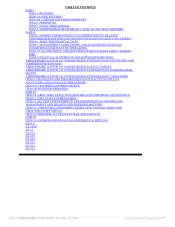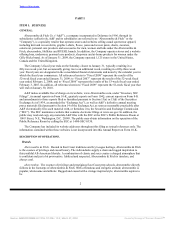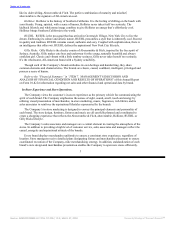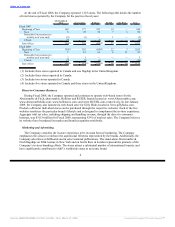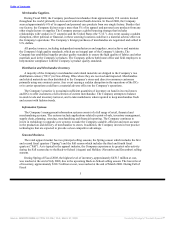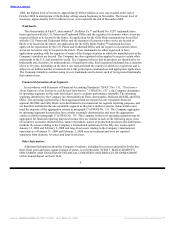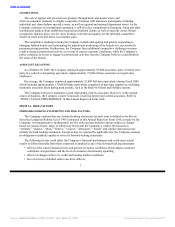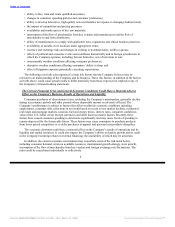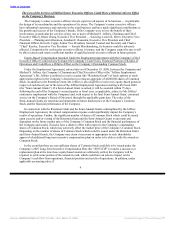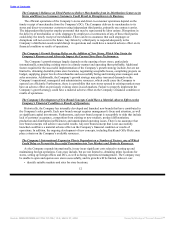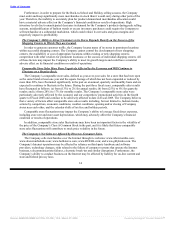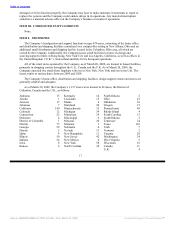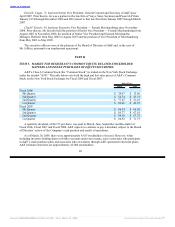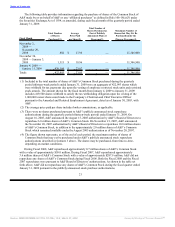Abercrombie & Fitch 2008 Annual Report Download - page 13
Download and view the complete annual report
Please find page 13 of the 2008 Abercrombie & Fitch annual report below. You can navigate through the pages in the report by either clicking on the pages listed below, or by using the keyword search tool below to find specific information within the annual report.
Table of Contents
trade, including exports to the U.S. Other events that could also cause disruptions to exports to the
U.S. include:
• the imposition of additional trade law provisions or regulations;
• the imposition of additional duties, tariffs and other charges on imports and exports;
• quotas imposed by bilateral textile agreements;
• foreign currency fluctuations;
• restrictions on the transfer of funds;
• the potential of manufacturer financial instability or bankruptcy; and
• significant labor disputes, such as dock strikes.
In addition, the Company cannot predict whether the countries in which its merchandise is
manufactured, or may be manufactured in the future, will be subject to new or additional trade restrictions
imposed by the U.S. or other foreign governments, including the likelihood, type or effect of any such
restrictions. Trade restrictions, including new or increased tariffs or quotas, embargoes, safeguards and
customs restrictions against apparel items, as well as U.S. or foreign labor strikes and work stoppages or
boycotts, could increase the cost or reduce the supply of apparel available to the Company and adversely
affect its business, financial condition or results of operations.
The Company Does not Own or Operate any Manufacturing Facilities and Therefore Depends Upon
Independent Third Parties for the Manufacture of all its Merchandise.
The Company does not own or operate any manufacturing facilities. As a result, the continued success
of the Company’s operations is tied to its timely receipt of quality merchandise from third-party
manufacturers. A manufacturer’s inability to ship orders in a timely manner or meet the Company’s
quality standards could cause delays in responding to consumer demands and negatively affect consumer
confidence in the quality and value of the Company’s brands or negatively impact the Company’s
competitive position, all of which could have a material adverse effect on the Company’s financial
condition or results of operations. Furthermore, the Company is susceptible to increases in sourcing costs
from manufacturers which the Company may not be able to pass on to the customer and could adversely
affect the Company’s financial condition or results of operations.
The Company’s Reliance on Two Distribution Centers Located in the Same Vicinity Makes it
Susceptible to Disruptions or Adverse Conditions Affecting its Distribution Centers.
The Company’s two DCs, located in New Albany, Ohio, manage the receipt, storage, sorting, packing
and distribution of merchandise to its stores and direct-to-consumer customers, both regionally and
internationally. The Company also uses a third-party DC in the United Kingdom for the distribution of a
portion of the merchandise delivered to the Abercrombie & Fitch flagship and Hollister stores located in
the United Kingdom. As a result, the Company’s operations are susceptible to local and regional factors,
such as system failures, accidents, economic and weather conditions, natural disasters, and demographic
and population changes, as well as other unforeseen events and circumstances. If the Company’s
distribution operations were disrupted, its ability to replace inventory in its stores and process
direct-to-consumer orders could be interrupted and sales could be negatively impacted.
11
Source: ABERCROMBIE & FITCH CO /DE/, 10-K, March 27, 2009 Powered by Morningstar® Document Research℠


